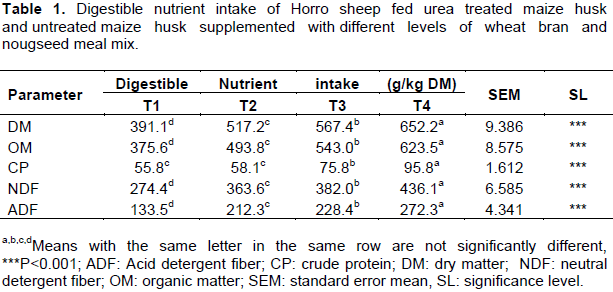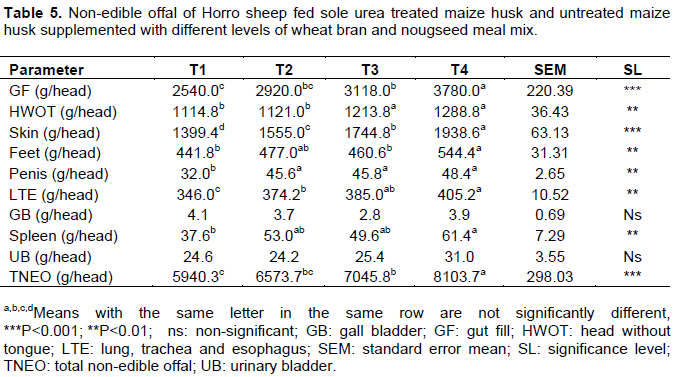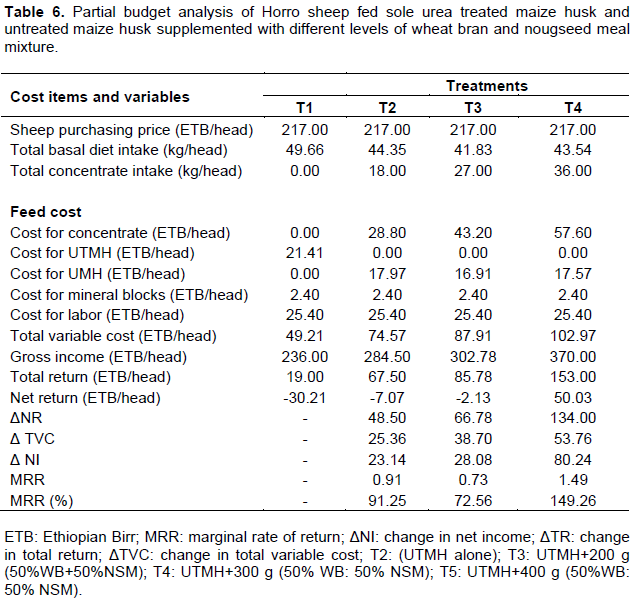ABSTRACT
The experiment was conducted for 90 days of feeding trial at Bako district, Western Ethiopia using twenty yearling male Horro sheep weighing 20.42 ± 0.35 kg (mean ± SD) with the objectives to evaluate the effect of supplementation of nougseed meal and wheat bran mix (1:1) on body weight (BW) gain and carcass characteristics of Horro sheep. The experiment was arranged with four blocks and four treatments in a randomized complete block design. The treatments were ad libitum feeding of urea treated maize husk (UTMH, T1) and untreated maize husk (UMH) supplemented with 200 g (T2), 300 g (T3) and 400 g (T4) of nougseed meal (NSM) and wheat bran (WB) mix (1:1) on the dry matter (DM) basis. Supplementation decreased (P<0.001) UMH DM intake as compared to intake of sole UTMH. Daily BW gain, final BW, empty BW, hot carcass weight and dressing percent (DP) were higher (P<0.001) in supplemented treatments. Sheep fed on the high level of supplementation (T4) had significantly heavier (P<0.001) rib eye muscle area and more muscle deposition. It was concluded that supplementation of Horro sheep with different levels of NSM and WB mix promoted BW gain, (DP) and increased the proportion of edible offal. Increasing trend of BW gain between the different levels of supplementation during the trial used in this study is an indication of the use of additional level than the high (T4) level of supplementation to obtain more BW gain in Horro sheep.
Key words: Body weight, carcass characteristics, concentrate mix, Horro sheep, maize husk.
In subsistence agriculture, which is common in developing countries like Ethiopia, farmers keep small ruminants for sale and household meat consumption where gross income is determined by the flock number raised by the owners (Gemeda et al., 2007; Temesgen et al., 2007). In fact, under Ethiopian condition, the aim of sheep producers is to get their lambs to slaughter weight in a short period of time with the maximum amount of lean meat, minimum bone and an amount of fat, which is desired by the consumers (Aschalew and Getachew, 2013). However, FAO (1997) reported that mean carcass weight of sheep is less than 10 kg per animal, which is the second lowest in sub-Saharan African. Gemeda et al. (2007) and Tesfa et al. (2013) suggested that, among many factors, plane of nutrition plays a major role in contributing to the variation in growth performance (carcass weight) and carcass compositions in sheep. Temesgen et al. (2007) noted that sheep productivity was based on large flock number, which is not viable option due to growing human population. Instead, intensified feeding may be one way to raise production per unit of animal in a sustainable way on the basis of available feed resource utilization as suggested by Shapiro et al. (2004).
Diriba and Lemma (2001) reported that maize is the major cereal crop in the western Ethiopia, particularly in the study area and its area of production is increasing from time to time more than other crops. As a result, the contribution of maize residues to animal feed resource is also increasing, particularly in early months of the dry season (Diriba et al., 2001; Thorne et al., 2002).
Maize husk is part of maize residue which is less digestible and low in available nutrients such as crude protein (CP) and digestible energy and slow rate of microbial fermentation (Adebowale, 1988; Ranjhan, 1997). These characteristics limit its intake and digestibility thereby hampering the productivity of farm animals (Nguyen, 1998; Undi et al., 2001). But, there are technical possibilities of upgrading the nutritive value of this residue by means of chemical treatment and/or proper supplementation of concentrates.
The objective of this study was to evaluate the effect of urea treatment and supplementation of different levels of concentrate mix on body weight gain and carcass characteristics of Horro sheep fed on maize husk.
Study area
The experiment was conducted at Bako District, Western Ethiopia, which is located at an altitude of 1650 m above sea level, and at 09° 06’ 56” N latitude and 37° 03’ 30” E longitude at about 239 km from Addis Ababa. The mean annual rainfall is 1242 mm, and the mean annual maximum and minimum temperatures ranges (13.3-27.9°C) during the period of 1961 to 2010 (Meteorological Station; Bako Agricultural Research Center).
Experimental design and feeding management
Twenty yearling male Horro sheep with initial body weight (BW) of 20.42 ± 0.35 kg (mean ± SD) and housed in individual pens were used in a randomized complete block design. The experimental sheep were grouped into four blocks with similar BW and one from each block was assigned at random to a treatment feed. The treatments consisted of ad libitum feeding of chopped cured urea treated maize husk (UTMH) (T1), ad libitum feeding of chopped cured untreated maize husk (UMH) and daily supplementation with 200 (T2), 300 (T3) and 400 g (T4) nougseed meal (NSM) and WB mix at 1:1 ratio. The supplements were offered in two equal parts at 8:00 and 16:00 h daily, and the experimental sheep had free access to mineral salt and water. Feed intake was recorded daily for the 90 days of feeding trial and BW was measured at ten days’ interval after overnight fasting. The cured UMH contained 93.56% organic matter (OM), 5.76% crude protein (CP), 75.8% neutral detergent fiber (NDF) and the NSM-WB mixture contained 94.61% OM, 24.13% CP and 41.1% NDF.
Determination of carcass components
At the termination of 90 days feeding trial, all sheep were fasted overnight, weighed and slaughtered. Different components of the carcass were separated, weighed and recorded for each sheep. The rib eye muscle area was traced between the twelfth and thirtieth rib and the area was measured with traced square paper. Empty BW was calculated as slaughter weight less gut content. Dressing percent was calculated as proportion of hot carcass weight to slaughter weight and/or empty BW. Percent of total edibleoffal (TEO) was calculated as the sum of blood, lung, trachea, heart, liver, spleen, empty gut, kidney and internal fat (mesenteric and kidney) weight to slaughter weight. Also percent of total non-edible offal (TNEO) was calculated as the sum of head, skin, genital organs, gall bladder and gut fill weight to slaughter weight.
Data analysis
Experimental data were subjected to the analysis of variance using the computer software SAS. Treatment means were separated by least significant difference test (LSD). The model for a randomized complete block design below was used for assessing the experimental data.
Yij= µ + Ti + Bi + Eij,
where Yij = the response variable, µ = overall mean, Ti = treatment effect, Bj = block effect, and Eij = random error.
Digestible nutrient intake
Within the supplemented group of sheep, all total digestible nutrient intake increased (P<0.001) with the level of supplement offered (Table 1). Similarly, Mulugeta and Gebrehiwot (2013) reported that the nutrient intake increases with the increase of level of supplementation with Sesame cake to sheep fed on wheat bran and teff straw. The digestible nutrient intake of UTMH (T1) is lower (P<0.001) compared to supplemented group. The digestible CP intake for T1 and T2 was similar (P<0.001) as the later offered lower amount of supplement which indicates potential of small amount of urea to provide CP for ruminants when added to poor quality roughages. Improved intake of urea treated cereal straw in sheep has been reported by other study (Getahun, 2013).
Body weight change and feed conversion efficiency
Differences (P<0.001) were observed in daily BW gain and final BW among the supplemented sheep. Positive correlation (P<0.001; r = 0.792) between CP intake and mean daily BW gain (Figure 2) was observed. Treatment diets resulted in a higher variation (P<0.001) in BW change and ADG. Sheep supplemented with concentrate feeds had higher (P<0.001) ADG as compared to those fed sole UTMH (T1). The maximum ADG of sheep was achieved by offering UMH with 400 g concentrate mix. Similar results were reported by Aschalew and Getachew (2013), Mulugeta and Gebrehiwot (2013), and Sultana et al. (2012). Based on this result, it can be concluded that supplementation can improve ADG at all levels used in the present experiment, perhaps through providing nutrients available for absorption or by enhancing microbial protein synthesis (Figure 1). This result is supported by Awet and Solomon (2009) and Zemicael and Solomon (2009) and Tesfa et al. (2013) that showed supplement rations improve BW gain, where different supplements have no equal potentials to supply nutrients for growth.
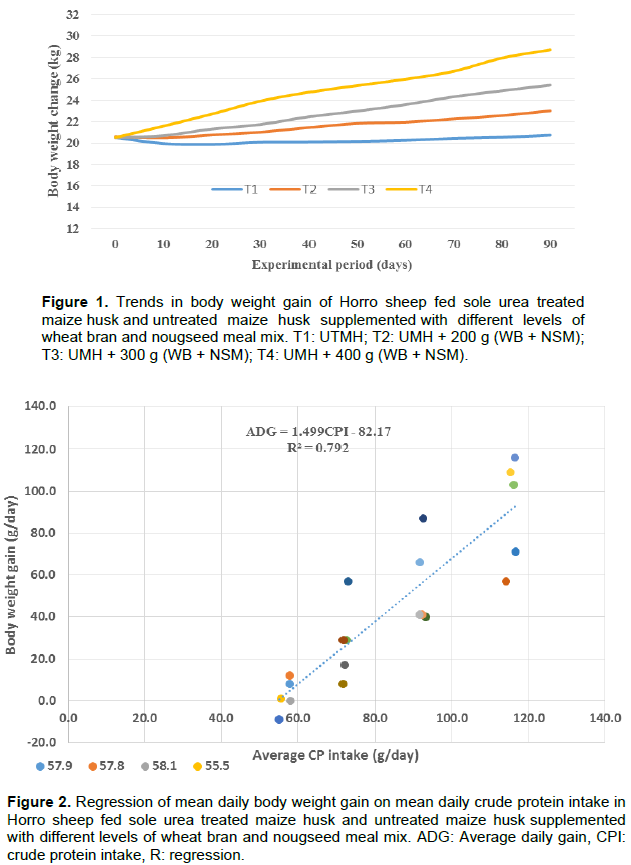
During the whole experimental period, the animals fed on UTMH maintained their BW. Similar results were obtained by Adugna and Frik (2000), in which supplementation of graded levels of Desmodium intortum hay to sheep fed on maize residue harvested at different stages of growth resulted in significant BW gain with increasing level of supplementation. The current lower BW gain in sheep fed sole UTMH despite its optimum CP content might be due to its high fiber content and the loss of volatile nutrients and ammonia from UTMH throughout the daytime that might have decreased the CP content to be less than 10.42% obtained in chemical analysis. Supplementation of concentrate mix increases growth rate of Bengal goats (Sultana et al., 2014) which corresponds to the present results.
Based on the present study, the optimum level of concentrate mix supplementation to UMH in terms of sheep BW gain per kg DMI was 400 g, in which maximum BW gain, better FCE and optimum net return was obtained. In the present study, the doubling of ADG with increasing level of supplementation needs attention and may show the potential feedlot performance of this breed (Table 2).
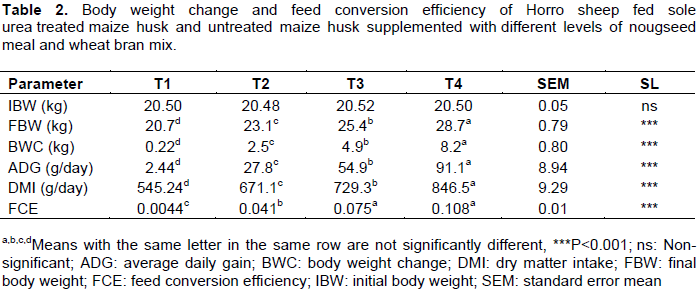
Feed conversion efficiency was higher (P<0.001) for treatments in the order T4=T3>T2>T1. The low FCE for UTMH (T1) was probably because of the lower CP and energy intake and higher fiber content of the diet that might have caused the use of net efficiency of metabolisable energy to be depressed significantly. The higher FCE with 400 g concentrate mix supplementation to UMH basal diet explained the nutritional advantage of concentrate mixes in providing absorbed nutrients by enhancing the maize husk nutrient utilization. In agreement with this result, Aschalew and Getachew 2013) and Mulu et al. (2008) reported improvement in FCE proportional to the levels of supplementation in sheep fed natural grass hay supplemented with treated grass pea and brewers’ dried grain, respectively.
Abebetl. (2009) also stated that improved feed conversion ratio was observed when Arsi-Bale sheep fed hay supplemented with wheat bran, linseed meal and their mixes.
Carcass characteristics
Evaluation and making a comparison of carcass yield and characteristics for animals under fattening program is a primary importance. Supplemented sheep had higher (P<0.001) values of slaughter weight (SW), empty body weight (EBW), hot carcass weight (HCW), dressing percentage (DP) and rib eye muscle area (REMA) than sheep fed sole UTMH (Table 3). Comparison between the supplemented group showed that SW, EBW and HCW increased (P<0.001) with increasing level of concentrate mix supplementation. In agreement with the current study, both Michael and Yayneshet (2014) and Gemeda et al. (2007) reported higher carcass parameters obtained for treatments under the highest level of feeding (250 and 400 g/day concentrate mix) of Tigray highland and Horro sheep compared to those treated under lower feeding levels, respectively.

Hot carcass weight comprises of bone and flesh excluding offal whether edible or non-edible. Sheep supplementedwith the highest (T4) level of concentrate mix resulted in a higher (P<0.001) HCW due to relatively more muscle development than others. Similarly, Tesfaye (2008) and Michael and Yayneshet (2014) reported that higher HCW for high level concentrate mix supplemented Arsi-Bale sheep fed urea treated maize cob.
Dressing percentage was higher (P<0.001) in T4 and T3 as compared to T2 for supplemented group. Comparison of DP as a proportion of EBW indicated that about 4% higher for each treatment than the DP as proportion of SW for each treatment, which can be attributed to the removal of the gut content (Table 3). Payne (1990) reported that there is improvement in DP as the proportion of concentrate in the diet increased, which is in agreement with the current study. T4 resulted in higher (P<0.001) DP which is in agreement with other indigenous Ethiopian sheep DP as SW at higher level of supplementation. Similarly, the result recorded on DP in the current experiment is consistent with the report of Ulfina et al. (1999) where concentrate feeding to aged Horro ewes improved carcass quality and DP.
The rib eye muscle area (REMA) was higher (P<0.001) in the order of T4> T3> T2 > T1 (Table 3). This indicates supplemented sheep were able to develop better muscle than T1. Comparable to the current study, Abebe (2008) reported REMA of 12.85 to 15.21 cm2 for Washera sheep fed on natural grass hay and supplemented with graded levels NSM, WB and brewery dried grain mix. Contrary to the present study, smaller REMA of 3.15 to 6.95 cm2 and 7.0 to 8.4 cm2 were reported by Abebe et al. (2009) in Arsi-Bale sheep at different levels of supplementation. The differences may be attributed to environmental factors, plane of nutrition and breed differences.
Edible offal
Offal components are edible or non-edible based on tradition, religion, culture and differences in norms and preferences of the people and is more or less subjective. Blood, testis, omental and mesenteric fat, tail, kidney fat and total edible offal components (P<0.001), tongue, empty gut and liver (P<0.01) and kidney (P<0.05) were higher in T4 compared to others. Lower (P< 0.001) total edible offal (TEO) was recorded in T1 and higher in T4 (Table 4). In agreement with the work of Tesfaye (2008) and Hirut (2008), supplemented sheep had higher weight of TEO compared to those fed on sole UTMH. This indicated improvement in TEO due to supplementation for sheep fed UMH basal diet. Smith (1984) and Michael and Yayneshet (2014) indicated that lamb carcass fatness is closely associated with BW and differences in their energy or dietary protein level in take when lambs are compared at same live weight.
Non-edible offal
Gut fill, skin and TNEO were higher (P<0.001) for T4 compared to other treatments. Head without tongue, feet, penis, spleen and (lung, trachea and esophagus) were higher (P<0.01) for T3 and T4 compared to T1 and T2 (Table 5). Total non-edible offal was higher (P<0.001) insupplemented sheep than sheep fed on sole UTMH. Mulu et al. (2008) and Abebe et al. (2009) also reported heavier TNEO for supplemented Wegera and Arsi-Bale sheep, respectively than the non-supplemented sheep fed basal diet of grass hay. In contrast to the present finding, Hirut (2008) and Michael and Yayneshet (2014) reported negative effect of level of supplementation on the percentage of TNEO in Hararghe and Tigray highland sheep, respectively. The difference might be attributed to breed, geographical location and type of feed offered.
Partial budget analysis
Sheep fed sole UTMH had a negative net return (-30.21 ETB/sheep) and it was the lowest among the treatments. The net return from the supplemented treatments was -7.07, -2.13 and 50.03 ETB/head for T2, T3 and T4, respectively (Table 6). Also T2 and T3 resulted in a negative and lower net return as compared to T4. This might be due to lower amount of concentrate supplementation to T2 and T3 that resulted in statistically lower BW gain as a result of lower nutrient intake. The marginal rate of return indicated that each additional unit of 1 ETB per sheep cost increment resulted in 1 ETB and additional 0.91, 0.73 and 1.49 ETB benefit for T2, T3 and T4, respectively. Therefore, among the supplemented treatments, T4 was found to be more profitable considering the net return and marginal rate of return, because sheep which had a better nutrient intake had higher average daily weight gain which results in a higher sale price.
Based on result of the present study, it is suggested that supplementations of Horro sheep with concentrate mix had a positive effect on feed intake, BW gain and carcass parameters. The positive response was more pronounced for sheep supplemented with highest level of concentrate mix with UMH basal diet. Moreover, the result of partial budget analysis (Table 6) indicated that the highest level of concentrate mix supplementation returned the highest profit than the other levels of supplementations. Therefore, supplementation of UMH with 400 g concentrate mix is biologically more efficient than the low level of supplementation and potentially more profitable, which tends to be economically recommended for feedlot fattening of Horro sheep.
The authors have not declared any conflict of interests.
REFERENCES
|
Abebe H (2008). Supplementation of graded levels concentrates mix on Feed Intake, Digestibility and Body weight of Washera sheep Fed Urea Treated Rice Straw. MSc Thesis Presented to School of Graduate Studies, Haramaya University. 64p.
|
|
|
|
Abebe T, Solomon M and Peters K. J (2009). Supplementation with linseed (Linumusi tatissimum) cake and/or wheat bran on feed utilization and carcass characteristics of Arsi-Bale sheep. Trop. Anim. Health Prod. 42(4):677-685.
|
|
|
|
|
Adebowale EA (1988). Maize residues as ruminant feed resources in Nigeria.
View
|
|
|
|
|
Adugna T, Frik S (2000). Supplementation of graded levels of Desmodium intortum hay to sheep feeding on maize stover harvested at three stages of maturity. Rumen fermentation and nitrogen metabolism. Anim. Feed Sci. Technol. 85:239-257.
Crossref
|
|
|
|
|
Aschalew A, Getachew A (2013). Supplementation of Raw, Malted and Heat Treated Grass Pea (Lathyrus Sativus) Grain on Body Weight Gain and Carcass Characteristics of Farta Sheep. Int. J. Soil Crop Sci. 1(1):1-6.
|
|
|
|
|
Awet E, Solomon M (2009). Supplementation of graded levels of wheat bran to intact and castrated Afar Sheep fed urea treated tef straw: Effect on feed intake, digestibility, body weight and carcass characteristics. East Afr. J. Sci. 3(1):29-36.
|
|
|
|
|
Diriba G, Lemma G, Adane H (2001). Grain and forage yield responses of maize genotypes intercropped with lablab purpureus under Bako condition, Western Ethiopia. pp. 247-257. Proceedings of the 9th Annual Conference of the ESAP held in Addis Ababa, Ethiopia.
|
|
|
|
|
FAO (Food and Agriculture Organization of the United Nations) (1997). Irrigation potential in Africa: A basin approach. FAO Land and Water Bulletin 4, 22. FAO, Rome, Italy.
|
|
|
|
|
Gemeda D, Tesfaye T, Takele K, Solomon A (2007). Evaluation of the impact of plane of nutrition on growth and carcass traits of Horro lambs castrated at different ages. pp. 13-22. Proceeding of the 15th Annual Conference of the Ethiopian Society of AnimalProduction (ESAP) held in Addis Ababa, Ethiopia.
|
|
|
|
|
Getahun KY (2013). Effect of wheat straw urea treatment & Leucaena leucocephala foliage hay supplementation on intake, digestibility, nitrogen balance and growth of lambs. Int. J. Livest. Prod. 6(4):89-96.
|
|
|
|
|
Hirut Y (2008). Supplementation of concentrate mix to Hararghe Highland sheep fed a basal diet of urea-treated maize stover: Effect on feed utilization, live weight change and carcass characteristics. MSc Thesis Presented to the School of Graduate Studies of Haramaya University of Agriculture, 29-48p.
|
|
|
|
|
Michael Y, Yayneshet T (2014). Feed utilization, digestibility and carcass parameters of Tigray highland sheep fed wheat straw supplemented with mixtures of wheat bran and cotton seed cake in Tigray, Ethiopia. A B C Research Alert 2(1).
|
|
|
|
|
Mulu M, Berhane T, Alemu Y (2008). The effects supplementation of grass hay with Different level of Brewery dried grain on feed intake digestibility and body weight gain in intact Wogera Lambs. East Afr. J. Sci. 2(2):105-110.
|
|
|
|
|
Mulugeta F, Gebrehiwot T (2013). Effect of sesame cake supplementation on feed intake, body weight gain, feed conversion efficiency & carcass parameters in the ration of sheep fed on wheat bran &teff (Eragrostis teff) straw. Momona Eth. J. Sci. 5(1):89-106.
|
|
|
|
|
Nguyen THN (1998). Utilization of some forage as a protein source for growing goats by smallholder farmers. Agricultural Faculty, Cantho University, Vietnam. Livest. Res. Rur. Dev. 10(3):261-266.
|
|
|
|
|
Payne WJA (1990). An Introduction to Animal Husbandry in the Tropics. 4th (ed.). Tropical Agricultural Series. Longman Singapore Publishers, Singapore. pp 472-502.
|
|
|
|
|
Ranjhan SK (1997). Animal Nutrition in the Tropics (4th ed.). Vikas Publishing House Pvt. Ltd., India, New Delhi. pp 301-371.
|
|
|
|
|
Shapiro BL, Mohamed MA, Reynolds L (2004). Socio-economic constraint to strategic sheep fatting. International Livestock Center for Africa (ILCA), Addis Ababa, Ethiopia.
|
|
|
|
|
Smith GH (1984) Opportunities for producing larger lean lambs. Aust. Soc. Anim. Prod. 16:99-100.
|
|
|
|
|
Sultana S, Khan MJ, Hassan MR, Khondoker MY (2012). Effects of concentrate supplementation on growth, reproduction and milk yield of Black Bengal goats (Caprahircus). Bang. Vet. 29(1):7-16.
|
|
|
|
|
Temesgen J, Gemeda D, Ketama D, Diriba G (2007). Evaluation of cow pea hay (V. unguaculata) vs. noug cake supplementation of Cynodon dectylon on growth performance and carcass characteristics of Horro rams. pp. 23-29. Proceeding of the 11th Annual Conference of the Ethiopian Society of AnimalProduction (ESAP), Addis Ababa, Ethiopia.
|
|
|
|
|
Tesfa G, Tegene N, Girma A, Arth L G (2013). Effect of supplementing grazing Arsi-Bale sheep with molasses-urea feed block on weight gain and economic return under farmers' management condition. J. Cell Biol. 7(10):125-131.
|
|
|
|
|
Tesfaye N (2008). Effect of supplementation graded level of wheat bran and noug seed cake mixture on feed utilization of Arsi-Bale sheep feed urea treated maize cob basal diet. MSc Thesis Presented to the School of Graduate Studies of Haramaya University.
|
|
|
|
|
Thorne PJ, Thornton PK, Kruska RL, Reynolds L, Waddington SR, Rutherford AS and Odero AN (2002). Maize as food, feed and fertilizer in intensifying crop-livestock systems in East and southern Africa. pp. 123: An exante impact assessment of technology interventions to improve smallholder welfare. ILRI Impact Assessment Series 11. ILRI (International Livestock Research Institute), Nairobi, Kenya.
|
|
|
|
|
Ulfina G, Solomon A, Gemeda D, Fikiru T, Girma A, Solomon G (1999). Response of aged Horro ewes to pre-market supplementary feeding. pp. 99. Proceeding of 7th Annual Conference of ESAP, Addis Ababa, Ethiopia. 26-27 May 1999.
|
|
|
|
|
Undi M, Kawonga KC and Musendo RM (2001). Nutritive value of maize stover/pasture legume mixtures as dry season supplementation for sheep. Small Rumin. Res. 40:261-267.
Crossref
|
|
|
|
|
Zemicael G, Solomon M (2009). Intake, digestibility, body weight changes and carcass characteristics of Tigray sheep fed diet of tef straw supplemented with sesame seed meal or wheat bran and their mixture. East Afr. J. Sci. 3(1):37-42.
|
|
